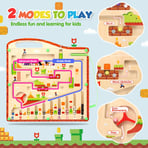
From Childhood to Adolescence: A Parent's Guide to Promoting Gender Health Awareness
The transition from childhood to adolescence is a crucial time for both children and parents. During this period, children begin to explore their gender identity and gender expression, making it essential for parents to promote gender health awareness. Understanding topics like puberty education, body image, and mental health can empower parents to support their children effectively. Open communication about healthy relationships and addressing gender stereotypes fosters a sense of inclusivity and acceptance. By equipping themselves with resources and strategies, parents can help their adolescents navigate the social pressures they face, build self-esteem, and develop essential coping skills during this transformative phase.
12/24/20243 min read







Parenting is a journey of growth, understanding, and adaptability. One of the most vital aspects of raising children today is fostering gender health awareness. As children transition from childhood to adolescence, they undergo significant physical, emotional, and social changes. During this period, parents play a crucial role in ensuring that their children develop a healthy understanding of gender identity, roles, and equality. This guide aims to provide parents with practical advice to navigate this essential topic.
Understanding Gender Health
Gender health encompasses an individual’s understanding and acceptance of their own gender identity, as well as respect for others’ identities and expressions. It includes awareness of societal influences, combating stereotypes, and promoting inclusivity. A healthy perspective on gender is essential for children’s emotional well-being, self-esteem, and social relationships.
Early Childhood: Building Foundations
In early childhood, children begin to form their understanding of gender. This stage is crucial for laying the groundwork for gender health. Here’s how parents can help:
Avoid Gender Stereotypes: Provide toys, books, and activities that defy traditional gender roles. Encourage exploration and interests based on the child’s preferences rather than societal norms.
Use Inclusive Language: Teach children that colors, hobbies, and careers are not gender-specific. For instance, avoid saying, “That’s a boy’s toy” or “Girls don’t do that.”
Introduce Diverse Role Models: Share stories and examples of people who challenge traditional gender roles, such as male nurses or female engineers. Representation broadens children’s perspectives and normalizes diversity.
The Transition to Adolescence: Navigating Complexity
Adolescence brings a heightened awareness of identity, societal expectations, and peer influences. This period can be challenging for both parents and children. Here are key strategies for promoting gender health during this time:
Foster Open Communication: Create a safe environment where your child feels comfortable discussing their thoughts and feelings about gender. Listen without judgment and validate their experiences.
Educate About Biological and Social Aspects: Help adolescents understand the difference between biological sex, gender identity, and gender expression. Use age-appropriate resources to explain these concepts clearly.
Support Self-Discovery: Adolescents may experiment with different ways of expressing their gender. Be supportive and affirming, even if their choices differ from societal norms or your expectations.
Address Bullying and Discrimination: Equip your child with tools to handle negative comments or behavior related to gender. Encourage empathy and educate them about standing up for themselves and others.
Model Respectful Behavior: Demonstrate acceptance and respect for all genders in your interactions. Children learn by observing, so your actions speak volumes.
The Role of Schools and Communities
Parents are not alone in promoting gender health. Schools and communities also play a critical role. Engage with your child’s school to ensure that gender-inclusive policies and practices are in place. Advocate for comprehensive education that includes discussions on gender diversity and equality. Additionally, seek out community groups or programs that support families in navigating these topics.
Challenges and How to Overcome Them
Promoting gender health may come with challenges, such as resistance from extended family members, cultural norms, or misinformation. To overcome these obstacles:
Educate Yourself: Stay informed about gender-related issues and seek credible resources to enhance your understanding.
Communicate Your Values: Share your beliefs and parenting approach with others respectfully but firmly.
Seek Support: Connect with other parents, counselors, or advocacy groups for guidance and solidarity.
Conclusion
Raising children with a strong foundation in gender health awareness equips them to navigate a diverse and inclusive world with confidence and empathy. By fostering open communication, challenging stereotypes, and supporting self-expression, parents can empower their children to embrace their identities and respect others. This journey may require effort and learning, but it is a vital step toward nurturing a generation that values equality and diversity.








Explore
Engaging tips for kids and tablet usage.
Learn
Play
123-456-7890
© 2024. All rights reserved.
